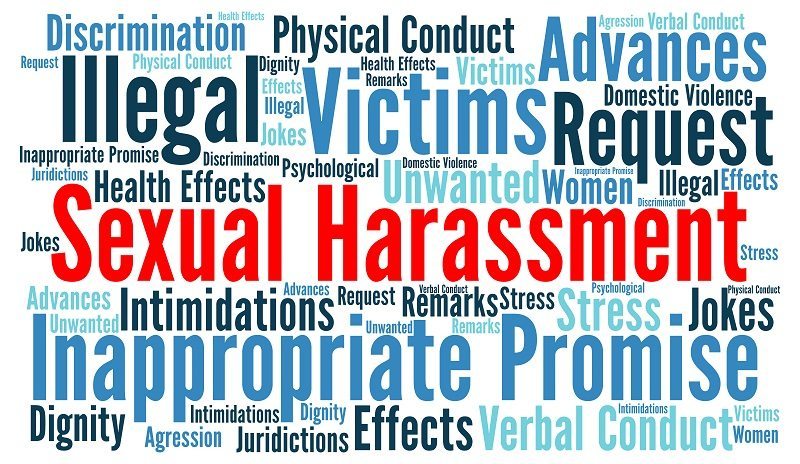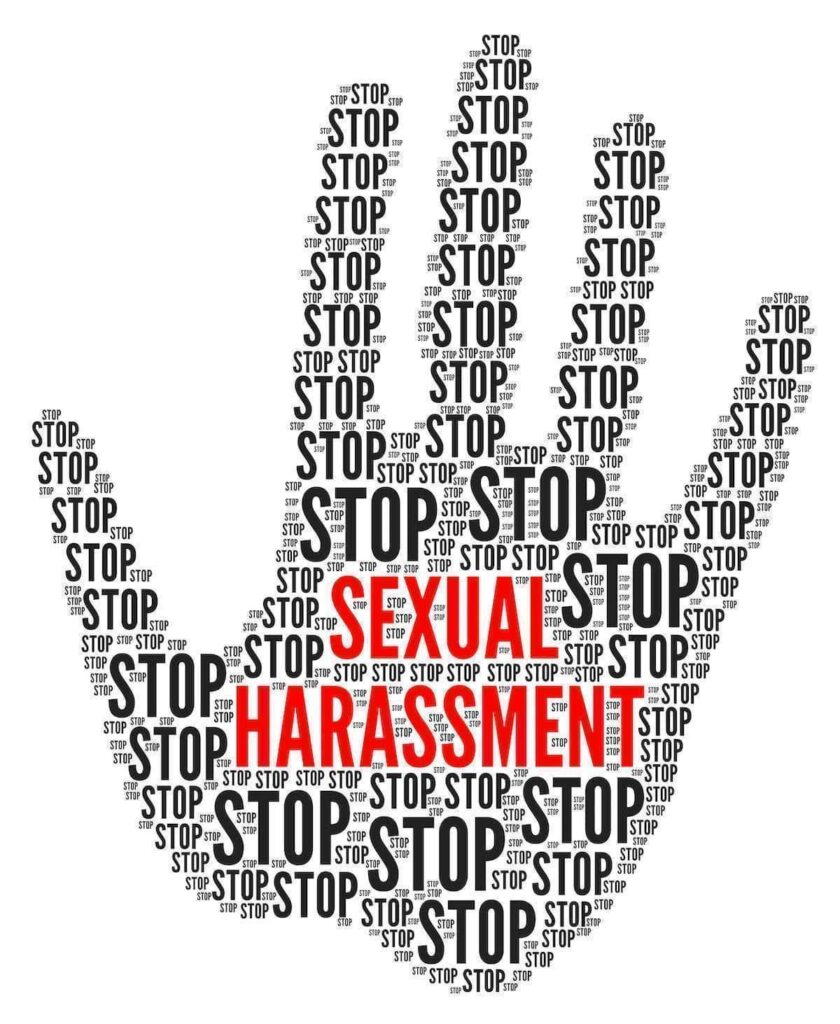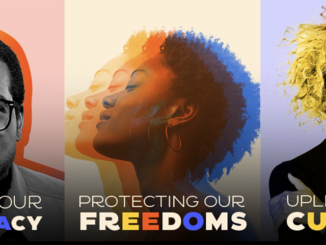
By Beverly Dawn Whatley, M.Ed.
What is Sexual Harassment?
In cartoons we found it amusing. The plump, little hen was being pursued by the salivating wolf, whose eyes rolled out of his head and back as he looked her over. Audiences laughed as his view of her became his intent—a succulent baked chicken. A male dog hounded a female dog, no matter how strongly she refused him, by popping up with gifts or with an exaggerated pucker, urging a kiss. We chuckled and munched our popcorn. This orientation to harassment was as acceptable as an anvil dropping from the sky on an adversary. These types of situations were the stuff of fiction and fantasy. They did not happen in the real world.
Sexual harassment involves the use of explicit or implicit sexual overtones, including the unwelcome and inappropriate promises of rewards in exchange for sexual favors [quid pro quo]. These unwelcome sexual advances, requests for sexual favors, nonverbal, verbal, or physical conduct of a sexual nature tend to create an offensive workplace [hostile work environment]. Sexual harassment includes a range of actions from verbal transgressions to sexual abuse or assault. Harassment can occur in any social setting including a school, the workplace, or the home. It can be direct or nondirect as in witnessed or overheard.
Harassers and/or victims may be of any sex or gender. The harasser may be a colleague or one in a position of authority. If sexual harassment occurs on the job site, persons who are the victims may sue under Title VII of the Civil Rights Act of 1964 (42 U.S.C.A. § 2000e et seq.), which prohibits sex discrimination in the workplace.
The U.S. Department of State has identified a partial list of offenses:
- Sexual pranks, repeated sexual teasing, jokes, or innuendo, in person or via e-mail
- Verbal abuse of a sexual nature
- Touching or grabbing of a sexual nature
- Repeatedly standing too close to or brushing up against a person
- Repeatedly asking a person to socialize during off-duty hours when the person has said no, or has indicated they are not interested
- Giving gifts or leaving objects that are sexually suggestive
- Repeatedly making sexually suggestive gestures
- Making or posting sexually demeaning or offensive pictures, cartoons, or other materials in the workplace
Hollywood glamorized it in older films. In one, a housemaid swoons because “he looks you up and down like searchlights”. Producers and directors have pressured the young and the new to do things during auditions or for the integrity of the character and the film that were not in the script or contract. The casting couch is not a myth. The “A-listers” negotiate to bring in body doubles to be their “torso” when nudity and sexual activity are considered integral to the story.
Is Sexual Harassment a new issue?
Federal courts did not recognize sexual harassment as a form of sex discrimination until the 1970s. Formerly, incidents were perceived as isolated flirtation in the workplace. It was not always based on a mutual attraction accompanied by PDAs. It just “went with the territory” of being a part of a workforce. Boys would be boys; girls had to be tough enough to take it.
One can imagine new hires were warned about “Jack in Accounting”, who fancied himself as a ladies’ man with a quick wit, or to be prepared to find off-color jokes and cartoons posted in the breakroom. Offenders were dismissed as harmless and adolescent.
Before we defined the “hostile work environment” it was like entering a room with a bad odor of unknown origin. It was unpleasant, but no one had been able to root out the source. One prepared to get accustomed to it for the duration.
Sexual Harassment in the Workplace
Although discrimination based on sex is covered in the Civil Rights Act of 1964, it was the first cases filed in the mid-1970s that gave sexual harassment an official name. It still took until the 1980s for the Supreme Court to catch up.
Before then it was playful and innocuous. Women were the usual recipients and just had to Teflon™ their way up the corporate ladder.
The insidious part of sexual harassment is that once a claim is filed, someone else gets to determine what is offensive, harmful, or serious enough to constitute discomfort or a hostile work environment, and how far the claim is pursued. The aggressor can be charged with misconduct. This professional person has exhibited unacceptable or improper behavior.
Recent national cases showing men of distinction have taken this from the sit-com stereotype of women passing a construction site or dealing with frat boys on a campus. These men have earned elected positions and leadership roles of respect yet could not stop themselves from indulging in the sophomoric humor or unnecessary observations of and unwanted attention towards the women who work with them. It can become a career ender.
Here’s an example. A woman with a prominent “derriere” cannot hide it. She has the same body type as her siblings. It may be a running joke in the family about “the butt sisters”.
At a family function it is expected, done in familial jest, and in a non-threatening manner. There may be additional barbs thrown about this one’s increase in weight and towards another for a decrease in hair. It’s what families do.
The workplace is another matter. Full skirts, straight skirts, slacks—it is still noticeable. Shapewear may slim and control excess jiggle, but her backside still draws attention. So, the head of H.R. sees her walking by and yells out, what’s your body mass index.” She may ignore him or give a low “I don’t know” which garners a “maybe I should come over there for a closer look.” Offensive? Imagine this to be your wife, mother, daughter, sister, best friend, or you.
This is not the Office of H.R. canvassing all employees about height, weight, and BMI collecting data to secure better or more affordable health insurance. This is one woman being singled out. A man in a position of authority over her has subjected her to unwanted recognition that has nothing to do with job performance. He has the power of evaluation and termination.
He cannot be avoided. His entitlement puts him above human decency. He is “Caesar”.
Let’s add, he is white, and she is black and younger. He dates women of color exclusively. He has the hubris of envisioning his membership as an honorary insider, making him exempt from accusations about race as he has a black girlfriend. He doesn’t realize his “little comments” fall under sexual harassment and microaggressions, nor does he know he has marginalized her away from other employees. It even makes it possible or permissible for a “boys will be boys” atmosphere to target her regularly. If she is bullied in the workplace because of her curves, is that harmful? This scenario would not be exclusively about race or age. Perhaps when we get a handle on critical race theory, we can tackle critical gender theory.
Blame the victim…
What were you wearing? Do you often work late? Do you travel alone? How long have you worked there? How did you find out about this party? Did you know anyone else there? Were you drinking? Who were you dancing with? Has this ever happened before?
The statistics about sexual offenses and women are alarming. Approximately 20% of American women have experienced anything from harassment to assault by the time they are adults; a third of them had this happen before the age of seventeen; for some, these instances were multiple; about 80% of cases of rape [and probably those of harassment] go unreported.
If a rape victim/survivor won’t come forward, it’s not a stretch to see why harassment is claimed long after, or also goes undisclosed. It’s like nothing ever happened. If a dog relieves himself in the house, when not corrected it is condoned. The message is: it’s okay to do this. The perpetrator may continue to torment the same person or go on to new victims. Safety in numbers could be behind the recent “Me Too” outpourings since the movement began in 2006.
One can find articles and nonfiction novels about women who attempt to insulate themselves against future attacks by gaining weight. As much as our society embraces women of all sizes, it becomes a matter of taking back control to pack on 50,100, or more pounds on a frame that has averaged 120 pounds, tops. The attempt at invisibility is a quest for safety.
Allow time to research the correlation between self-medicating behaviors and suicide after sexual harassment, especially when the aggressor goes unscathed.



Objectification of Women
There are unfortunate and double entendre messages on T-shirts that invite sexual commentary. There are types of clothing that attract attention. Corporate, club, and costume garments are very different. A costume in the office or club attire at a conference will pull attention. There is a time, place, and outfit for all occasions.
This writer has been employed in four body-based professions. As a model, actor, showgirl, and Playboy Bunny one’s body is scrutinized as a part of the job. It was accepted that walking the runway or putting on the “ears and tail”, one was going to be looked at and commented upon. This was not a by-product. It was the product.
Conversely, working in corporate, retail, or education in normal business clothing it is not expected that one would have to deflect and defend. As women, we must hold a certain amount of accountability in how we present ourselves. If one chooses to wear an oversized polka-dotted jumpsuit, a rainbow fright wig, and a red ball as a nose, can one blame others for making clown comments? It is another example of a “look at me” outfit.
This does not let anyone off the hook. We must raise our boys to be true men of quality. One may have difficulty controlling thoughts, but what forms in the mind does not have to fly from the mouth. We also need to empower girls to become women who exercise good judgment in how they present and represent. Dressing and demeanor are like preparing for a project. Consider purpose, audience, and the desired outcome.
When women are the aggressors
This is not a one sided societal ill. As women make up most of the instances with men as perpetrators, let’s address when women become predatory.
Unsolicited touching, unnecessarily close proximity, inappropriate humor, staring at and talking about male body parts is harassment. Men may be less likely to come forward out of fear of appearing weak or less than straight. This is more difficult if the woman is attractive and/or has a position in the company that could catapult a man’s career with a bit of “cooperation”.
Other men may envy this attention: Why would you complain? She’s fine. She can get you that corner office.
Here are some examples. A well-groomed man is shown appreciation by, that’s a great looking shirt and tie. It becomes uncomfortable when you look good in that shirt and feel even better is accompanied by a hand running up his chest or down his back. Like the shoes? Those are some fabulous shoes should be the end. Adding…they look about a size 12. You know what they say about men with big feet…is an invitation to a reprimand. Imagine this as your son’s first real job, or the way you meet the new department manager.
What’s being done?
Some school districts mandate Safe Schools Training. These modules include child abuse, bloodborne pathogens, cyber bullying, diversity awareness, and sexual harassment. They must be completed before a target date as a term of employment.
Some organizations require sensitivity training as a part of professional development, or as the re-education of those who have culturally or sexually offended co-workers.
As a society, we must begin by teaching our children that words and actions have consequences. Would it be olde-fashioned to reinstate ”the Golden Rule”? We won’t have to repair that which doesn’t get broken. Our schools, workplaces, and homes should be places where we are productive, comfortable, and unconditionally safe.
If an incident occurs, you are not alone. There is help available.
Resources:
If you are an employer or a Director of Human Resources and you want to investigate training for the organization or for individuals:
Online Sexual Harassment Training for Employees, Managers, Supervisors
Sexual Harassment Training – Online and Video Programs (jjkellertraining.com)
If you have been a witness to or victim of sexual harassment and you need support in navigating your next steps:
Sexual Harassment Resources | RAINN
If you are military:
Military Sexual Trauma: Resources – Mental Health (va.gov)
Locally:
Contact your county agency for Domestic Violence/Sexual Assault for resources near you. If necessary, check for an attorney who specializes in civil or criminal cases, if you are a victim or the accused.
About Beverly Dawn Whatley
Beverly Dawn Whatley is a writer, actor, educator, and activist. She has championed awareness about Domestic Violence and Sexual Assault in California and Michigan from serving on a Board of Directors to producing a documentary. A graduate of Eastern Michigan University, Beverly completed her graduate studies at Chapman University in Southern California. As an actor/performer she has credits from TV, film, nightclubs, and television news. Her teaching experience ranges from middle school to college. She is also an instructional coach for the state of Michigan. Most recently, Ms. Whatley was featured in B.L.A.C. Magazine, a Detroit-based lifestyle and culture publication. Her mantra: Be the change you want to see in the world.








